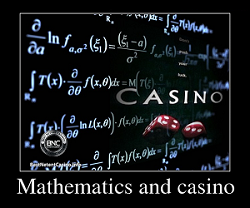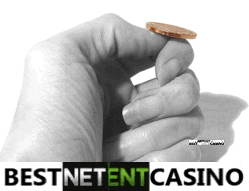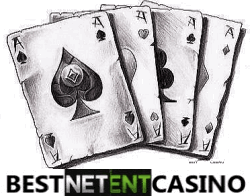Last Updated: Monday, 06 January 2025 11:47
Mathematics and casino

In this article, we will cover the basic principles on which the activity of gambling houses is based, as well as how they get profit and how lucky they may be. Let us start with the basic mathematical laws on which gambling is built. What is the connection between mathematics and the casino? A lot of casino games were created and developed by mathematicians. May we use their weapons to get an advantage over the casino?
A bit of history
In 1526, Italian mathematician Geralomo Cardano for the first time, tried to describe the dice game with the help of mathematics in his "Book on Games of Chance". By having a study on his gaming practice, he tried to develop and theoretically justify the system of recommendations of the stakes management. He was the one who defined probability:
"Probability theory is concerned with determining the relationship between specific given event occurs sometimes and a number of times an event occurs."
Later, at the end of the 16th — beginning of the 17th century, the mathematical analysis of the dice game was continued by Galileo Galilei and Blaise Pascal. They started doing this at the request of their friends who were big gamblers with huge gambling experience. It must be acknowledged that the science of probability, according to history, grew out of the mercantile problems of the players.
It is commonly believed that at that time, the whole new branch of mathematics was born, wholly dedicated to probabilities. The next step in this direction was made by Dutch mathematician Christiaan Huygens, who published a book in the middle of the 17th century "On Reasoning in Games of Chance" ("De Ratiociniis in Ludo Aleae"). The further development of the probability theory was done in the writings of many great mathematicians of the 18th-19th centuries – Jacob Bernoulli, Poisson, Laplace, Moivre, and others. It did not take long before this new theory became widely used in the spheres which are entirely different from gambling.
Mathematics at the slots

The probability is how often an expected outcome may happen, and it is represented as a ratio of expected outcomes of the total possible results at a large number of retries within an extended period.
The probability of an outcome reflects the quantitative possibility of that outcome. If it is equal to zero, that outcome may not happen at all. If it is equal to 1 (100%) – the outcome will happen. You may find practical advice on the use of mathematical calculations at the casino on the following page:
Examples
A standard deck has 52 cards, including 4 ACES. The probability of getting an ACE is: (4 / 52) * 100 = 7,69%. European roulette has 37 numbers on the wheel: 1-36 – numbers (18 reds and 18 blacks) and zero is in coloured green.
- The probability of getting any of the numbers - (1/37) *100=2,7%.
- The probability of getting a red number – (18/37) *100=48,6%.
- The probability of getting dozen – (12/37) *100=32%.
Win/loss ratio

- While rolling two dice, there are 36 outcomes (a cube has six faces, each of which can match any of the faces of the other cube).
- Consider the probability of getting seven from two dice rolling. It may happen in the following outcomes: 3 and 4; 5 and 2; 6 and 1; 4 and 3; 2 and 5; 1 and 6. Therefore, 5 (out of 6) outcomes are negative and just one positive. The loss/win ratio, in this case, is 5 to 1.
- The given an example consists of mutually exclusive outcomes: you get the numbers which make 7, or you do not get the numbers which make 7. These are called mutually exclusive outcomes/events if, under any circumstances, they may not happen at the same time.
Opposite events
- Opposite the event - it's a compliment. The complement of heads is tails, the complement of red colour is black, and the complement of odd is even. The probability of all potential outcomes always equals 1.
- For example, at getting a random card from the deck, there will be either hearts [13 / 52, or 25%], or any other suit [39 / 52, or 75%]. So, we have: 13 / 52 [25%] + 39 / 52 [75%] = 52:52 = 1 [100%].
- Let us see what the probability of getting hearts or spades is. These events are mutually exclusive, and the probability of each of them is 13 to 52. The chance of getting hearts or spades is 13/52 + 13/52 = 26/52 = 1/2 [50%]
- Casinos are based on the same mathematical laws and principles.
Independent events
If the probability of an event outcome does not affect the probability of another, these events are called independent. Let us toss the coin twice. The second outcome does not depend on the first one. Both of these events do not affect each other, so they are independent.
- The probability of getting tails in one of the coin tosses is: (1/2)2 = 1/4 (or 25%)
- The probability of getting tails ten times in a row is: (1/2)10 = 1/1024 (or 0.098%)
- In one of the casinos in Las Vegas, a pair of dice was presented. The inscription reads that the uniqueness of these dice is unmatched thanks to their 28 straight passes, which happened once. Note that the probability of getting 28 consecutive passes in a DICE game is (0,493)28, or approx. 1 out of 400 million. So, the casino recognises the mathematical uniqueness of this event.
Dependent events

- Let us have a mathematical calculation of the positive outcome of the given event: 4/52 * 3/51 * 2/50 = 0,000181, so one positive result out of 5525 tries.
- Each of the three events consistently affects the probability of the outcome of the next one, so the events are dependent.
- If each card we get is returned to the deck, the events are independent. Consequently, the probability of getting 3 ACEs is 4/52 * 4/52 * 4/52 = 0,000455, so 1 positive outcome out of 2197 tries.
- Each of the three events consistently affects the probability of the outcome of the next one, so the events are dependent.
Mathematical expectation (Expected Value)
The essence of understanding the mathematical expectation (also known as gambler expectation, expected value) is quite simple. Speaking clearly – it is the amount of money you can win or lose within an extended period, provided that you are going to make the same bet.
You may want to calculate the value of mathematical expectation using the following formula
МО = (the number of positive outcomes [wins] / the number of possible outcomes) * the amount of the winning + (the number of negative outcomes [losses] / the number of possible outcomes) * the bet amount. Many of you will see this as a Chinese inscription, but it is quite simple.
Example
Your bet is 1$ on hearts to be the first card. According to the probability theory, positive outcome (you get the hearts, and you win +1$) will happen with a probability of a ¼, negative outcome (you get another suit, and you lose 1$) will happen with a probability of ¾.
Let us calculate the mathematical expectation using the above formula:
МО = 1/4 * (1$) + 3/4 * (-1$) = - ½$
So, within a long period your loss will be 50 cents for every dollar bet, so, according to the mathematics, four spins will make you lose three times, 1$ each (you get a loss of 3$) and win a single time - 1$.
Mathematical expectation at roulette

As you have probably noticed, in both given examples, the value of mathematical expectation has a "-" (minus), it is typical to most casino wagers. Negative mathematical expectation means the longer the game, the higher the probability of loss.
Casino advantage (House Edge) [house percentage] is the value which is opposite to mathematical expectation of the gambler; it is the casino advantage (percentage) over the gambler. The casino advantage in European roulette is 1 - 36/37 = 2,7%, in American - 1 - 36/38 = 5,26% (thanks to two zero sectors). This means that if you bet $1000, the probability of losing 27$ (in European roulette) and 54$ (in American roulette) is quite high. At table games, the casino advantage is lower (Baccarat, Blackjack or Craps).
Let us take American roulette, which has 36 numbers and 2 zero sectors. Suppose we bet on a number. In this case, the probability of a win is 1 to 36:
- Probability of win: 1/38 or 2,63%;
- Possible winning (the percentages to wager): 1/38 * 36*100 = 94.74%;
- Casino percentage: 100 – 94,7 = 5.26 %;
- Mathematical expectation: (1/38) * 36 (+1) + (37/38) * (-1) = -0,0263.
- So, from each dollar bet at the casino may get 2,63 cents. In other words, the mathematical expectation in American roulette is 2.6% from each of your bets.
Mathematical dispersion at slot machines
In mathematics, the dispersion is a statistical measure that tells you how measured data vary from the average value of the set data. In our case, it is a risk degree. Dispersion is the deviation degree of the outcome from its mathematical expectation when it comes to gambling. The dispersion makes the game unpredictable; you either win or lose.
The gambling houses exist thanks to the dispersion: any outcome would be calculated mathematically. The dispersion is neither a positive or negative factor, and it exists by itself as an objective reality. To some extent it compensates negative mathematical expectation, allowing the gambler to win (at a short distance). At the same time, it does not allow to create a working system which guarantees winnings at a long distance.
It should be noted that when betting on "colour" the dispersion in roulette is almost absent. In practice, however, there are records of 15 straight droppings of the same colour. Learn more about dispersion in the following articles:
Law of large numbers

By tossing a coin ten thousand times, we get a balanced expected value (50%). The probability of getting 60% or a larger number of tails at a random toss of 10 coins = 0,377. Let us get the same for one hundred coins. The probability of getting 60% of tails equal to 0,028, or approx. 1 out of 35. If tossing 1000 coins, to get 60% or a larger number of tails is quite impossible. The probability of this event equals 0.000000000136 (less than 1 out of 7 billion). We will not get the 50% of tails, but the more coins we have, the closer we are to the average value (50%).
That is how the "law of large numbers" works: the accuracy of the expected outcome ratio (according to the probability theory) is higher when we have a larger number of events. By using this law, you may accurately predict only the outcome of a series of similar events. Although the outcome of each event is unpredictable, it is balanced at a long distance.
How to get a positive mathematical expectation at the casino?
On our site, we have a list of strategies and recommendations which should be used to get a positive mathematical expectation at slots. It is based solely on mathematical calculations, taking into consideration the payout percentage of each of casino games and the betting requirements of the bonuses. Find out more on the following page:
Conclusions
You do need to be a great mathematician to play at the casino. You may not even calculate mathematical expectation and dispersion – it was done long before, as you can use existing information. The main thing is to realise that the games with a high value of mathematical expectation (especially the positive one) are more profitable for the gambler, by getting it you have an advantage over the casino. Play at European roulette (with a single zero sector), here the casino advantage is 2,7% when at American roulette (with two zero sectors) it is 5,26%.
We recommend you keep an eye on an online casino, where you may find roulette with no zero sectors (Zero edge Roulette). It is the most profitable roulette. In this case, the casino advantage is lowered from 2,7% (European roulette) to 0. The truth is that it is compensated by some rules which I strongly recommend reading carefully before starting the game. It is the percentage the casino takes either as a fee applied to your stake or your winnings. I guess the last one is the best choice.
In any case, we should not forget about dispersion. The higher it is, the more stressful the game. Remember, the mathematics in gambling works correctly only at a large number of tries; so, calculating the expected values is quite difficult, due to the limited budget, the bet size or playtime.
Where to play?
- Playing at Fastpay casino, the mathematical expectation of receiving your requested withdrawals (if you are not breaking the rules) is 100%. The most recommended gambling site.





